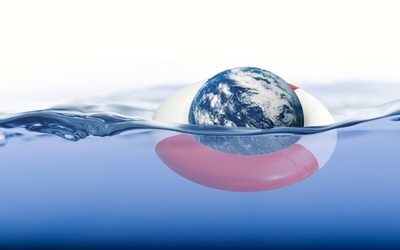What Do Rising Sea Levels Really Mean For The Planet?
Although the most recent U.N climate report significantly increased its projections for the sea level rise for this century, some scientists warn that even those estimates are extremely conservative. The only thing we know for certain is that predicting sea level rise for the future is an incredibly difficult task. When the scientists on the Intergovernmental Panel on Climate Change (IPCC) met to discuss the sea level rise for this report, they found it a far harder task that initially anticipated. Sea level forecasts were arguably the most controversial part of the previous report, issued in 2007, and scientists and the public alike have found the estimate of under 60 centimetres to be incredibly low, which doesn’t even include the possibility of rapid ice flow from Greenland or the Antarctic into the sea. These two ice sheets hold the ability to raise sea levels by an astonishing 65 metres, compared to just 0.4 metres in all of the world’s mountain glaciers. Because such things have been neglected, we can’t determine an accurate projection from the figures released.
However, things today look slightly more certain. In the latest report, the IPCC said they could finally put a number on the ice flow from the poles. The result of the estimate was the belief that the sea level rise would be in the region of 28 to 98 centimetres, with a maximum of more than three feet, by 2100 over 50 per cent higher than the 2007 projections. However, this doesn’t mean that sea level rise problems are now fully understood. In fact, far from it – scientists are still battling big questions surrounding the fate of the ice sheets and this could greatly increase the recent projections by a vast majority. Researchers still don’t know how quickly these predictions will become a reality, and there are many more smaller factors still being contended with.
The oceans don’t rise steadily like water being poured into a bathtub; instead there are splashes and movements as it rises. Patterns in the weather, such as with El Nino can shove tens of centimetres of water onto the shores of countries at a time, much like they did in California in 1998. Take the floods in 2010 in Australia as an example. And with the ocean growing, the land also shifts. The ground rises where it was once pressed down by glaciers, and then the river deltas sink as the sediments compact. So what looks like the sea levels rising on first glance may actually be the result of the land falling. Unravelling what the oceans are doing currently is a difficult thing to do, and predicting their behaviour is even harder. Everyone is committed to sea level rise, but no-one knows exactly what that means or when it’s likely to happen. Whichever way we look at this issue, the results of the studies are cause for concern. Scientists are even suggesting that people who live under three feet sea level, they should be concerned for the next 100 years.
People are able to adapt to a certain extent but we have a difficulty in the fact that people aren’t planning for the reality. There need to be many changes to the way people live in order to cut their carbon footprint drastically in order to lower the increasing risk of sea levels rising, and other environmental effects of global warming. When people make these changes, researchers can begin to look into the ways we can adapt our lifestyles accordingly.

Comments are closed.